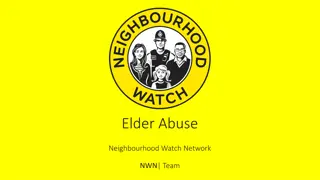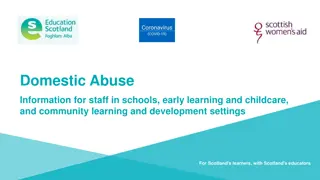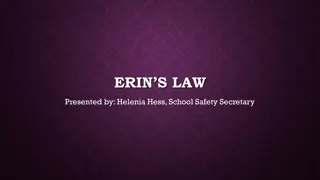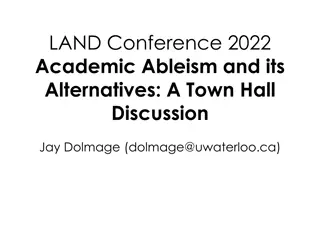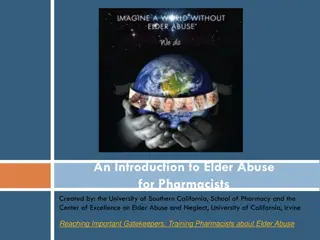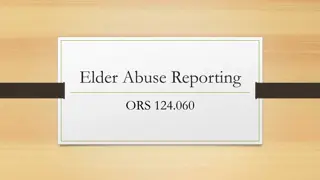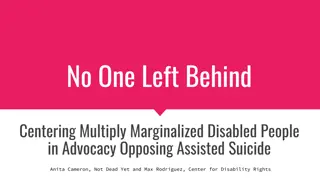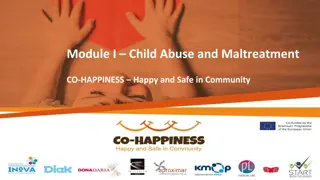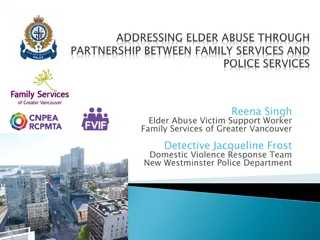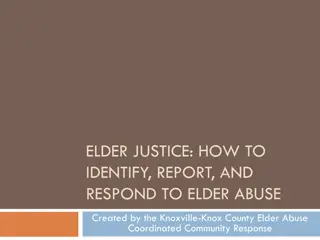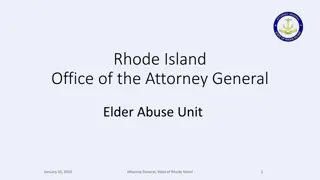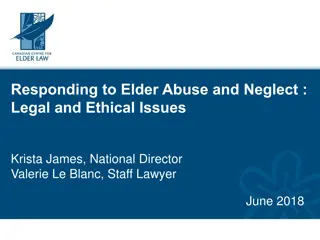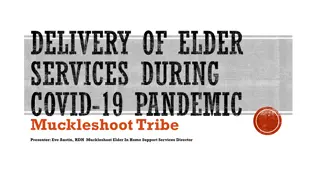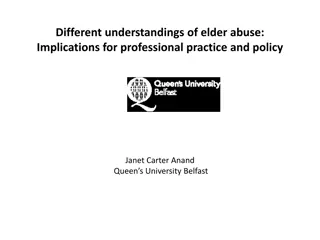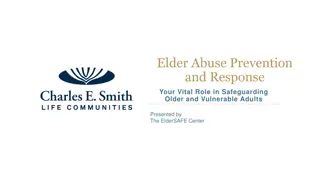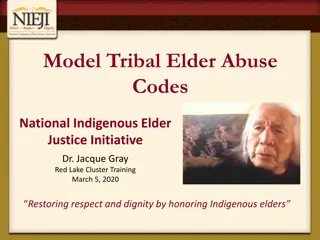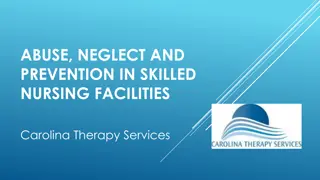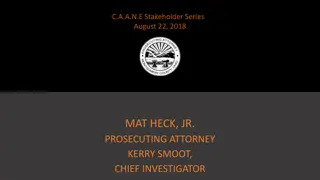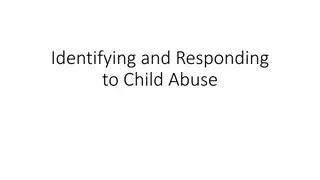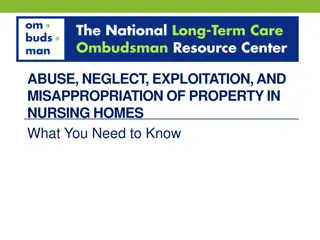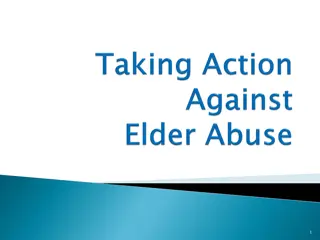Understanding the Impact of Ableism in Elder Abuse Prevention
This presentation focuses on the harm of ableism in preventing elder abuse, presented by Ali Chiu at the Elder Justice Summit. The material covers key training objectives such as exploring the history of disability in the U.S., understanding ableism, and discussing tools for responding to abuse reports. The content touches on addressing biases, supporting survivors, and promoting collective access. Additionally, it sheds light on the intersectionality of disability, abuse, and marginalized identities, emphasizing the importance of inclusive and respectful responses.
Download Presentation

Please find below an Image/Link to download the presentation.
The content on the website is provided AS IS for your information and personal use only. It may not be sold, licensed, or shared on other websites without obtaining consent from the author. Download presentation by click this link. If you encounter any issues during the download, it is possible that the publisher has removed the file from their server.
E N D
Presentation Transcript
Understanding the Harm of Ableism in Preventing Elder Abuse Elder Justice Summit Sept 20, 2023t This presentation material is developed by Ali Chiu and members of National Human Trafficking and Disabilities Working Group
Ali Chiu Ali Chiu has been a public service provider since 1999. Her focus has been on anti-violence (domestic violence, gender-based violence, sexual exploitation, & human trafficking). She also has been an advocate on rights of seniors and people with disabilities. She is currently the Lead Supervisor of Consultative Services of Institute on Aging and is a Steering Committee member of the National Human Trafficking and Disabilities Working Group. Ali also holds a community seat on the San Francisco Family Violence Council. Ali is a survivor of domestic and sexual violence, a woman of color, an immigrant and a person with a disability.
Grounding Acknowledge your Intentions Centering Survivors/Victims Examine Your Assumptions and Biases Explore Support Create Collective Access
Training objectives: Explore the U. S. history of disability and the relevant movements in relationship to current policy and laws Explore the definition of ableism, its different forms, and the relevance of language, culture, and barriers Discuss critical, respectful, and accessible tools when responding to reports of abuse
You are a 56-year-old Chinese American woman living with your partner in San Francisco. You and your partner bought yourapartment together 10 years ago, mostly with money from your parents. You have lived with several disabilities for most of your life. You use a wheelchair outside, and at home, you manage basic tasks with your attendant, who comes in a few days a week. You enjoy swimming, writing, and reading. You are an editor, but you haven t been getting enough work lately. You have a Labrador named Ruby as your service animal. You and your partner have been together for over 25 years. Your partner is ahomebody who loves to cook, write, and watch movies on the computer. Your partner also likes to keep your apartment extremely clean and does not like to have people over. You, on the other hand, enjoy seeing friends and often enjoy entertaining friends at home. You believe the aforementioned issues to be at the core of your longstanding conflicts. In response, you have begun to go out more rather than have people over, but your conflicts persist...
Situation 1 Situation 1 A couple of weeks ago, you and your partner had an argument over Ruby being sick in the apartment. You tried your best to clean it up, but your work didn t meet your partner s standard so your partner pushed you out of your wheelchair to stop you from going out to meet with your potential new boss. You fell on your face, chipped your front tooth and bruised the left side of your face, along with your arms and legs. stay home domestic violence shelter your sister s place motel (you only have $2000 cash) friend s house (Oakland not near public transportation) What would you do?
Demographics of Elders and Dependent Adults According to the Centers for Disease Control & Prevention, 27% of the U.S. population, or approximately 61 million Americans identify as people with disabilities. That s one in four people, making persons with disabilities the largest and most diverse population group in the country, representing all abilities, ages, races, ethnicities, religions, and socio-economic backgrounds. According to the U.S. Department of Justice Crime Against Persons with Disabilities report (2009-2019), women and girls with disabilities face the highest rates of physical and sexual violence. An NPR investigation finds people with intellectual disabilities are raped at a rate seven times higher than those without disabilities. Women with disabilities have a 40% greater chance of intimate partner violence than those without disabilities
Ugly Law Eugenic Movement Independent Living Movement Sec 504 Rehab Act Fair Housing Act ADA Olmstead Decision Brief Overview of Disability Rights U. S. History
A system that places value on peoples bodies and minds based on societally constructed ideas of normality, intelligence, excellence, desirability, and productivity. These constructed ideas are deeply rooted in anti-Blackness, eugenics, misogyny, colonialism, imperialism, and capitalism. ABLEISM a ble ism \ b - li-z m \ noun This form of systemic oppression leads to people and society determining who is valuable and worthy based on a person s language, appearance, religion, and/or their ability to satisfactorily [re]produce, excel, and "behave. You do not have to be disabled to experience ableism. - a working definition by Talila "TL" Lewis*; updated January 2021 Developed in community with Disabled, Black and other negatively racialized people, especially Dustin Gibson.
Language Consideration Do NOT use paralyzed crippled and/or demented to describe your feelings, your fear, the traffic home, the current economy, etc. Dumb, lame, insane, crazy do NOT mean unintelligent or stupid Wheelchair-bound, handicap and the R word are harmful and NOT how people with disabilities like to be described Understanding our privilege when we speak. Words have power. Not using words and/or phrases that would continue to perpetuate oppression Dumb, lame, insane, crazy, DO NOT mean unintelligent or stupid It is ageist to use a phrase such as having a senior moment when referring to forgetfulness Do NOT use paralyzed , crippled and/or demented to describe your feelings, your fear, the traffic home, the current economy, etc. Wheelchair-bound, handicapped and the R word are harmful, and NOT people with disabilities like to be described.
Abuse Through Ableist Lens Isolation using disabilities culture to isolate survivor, denial of access to communication, information, pathway, healthcare, culture and religious practice, and more Emotional Using disability to manipulate and control, threats, put- downs, name-calling, ridicule of personal/cultural beliefs, threats against family members, pets, immigration/disabilities/LG BTQ+ & HIV status, minimize, and manipulate . Physical Hitting, pushing, punching, slapping, under and/or over-medicating. Sexual Inappropriate unwanted touching, watching, recording, or photographing. Inappropriate unwanted massages, non- consensual intercourse, exposing of genitals, exposing to pornography. Financial No access or knowledge of money movement, control of spending/non-spending, access of employment/education, trafficking/exploitation Abandonment Refusing to provide proper food, housing, or medical care. Neglect Failing to meet basic needs of daily care including water, hygiene, clothing. 11
People with disabilities are also vulnerable to human trafficking Some known exploitation cases of people with disabilities in the U. S. 57 deaf Mexican immigrants including three pregnant women and 12 young children trafficked to work in New York *1997 Iowa Turkey processing plant workers with developmental disabilities exploited, some for over 60 years *2014 Rock River Valley Self Help Enterprises of Illinois pays workers with disabilities gift cards - *2018
A human trafficking case in San Francisco 2021 Danielle was 47. Her sister was supposed to manage her SSI and CalFresh (food stamp) benefits but because her sister didn t pay her rent on time for many months Danielle was evicted and became homeless. She had no tools to access her CalFresh Food Stamp) and depended on free meal programs. Furthermore, Danielle was sexually exploited on the street and physically assaulted many times. *name of victim changed for confidentiality
Lack of reasonable accommodations Physical Barriers Communication Barriers Program Barriers Believability/Credibility/Respectability Barriers Financial/employment barriers Absence of accessible Long term supports Domestic/Caregiver Abuse Abuse to Prison Pipeline Lack of trust for police/government interventions Barriers for people with disabilities to reach out when experiencing abuse
Prioritizing Survivor Safety Consider Question Offer Create Provide Promote Consider the impact of carceral living conditions when recommending safe/accessible housing options for survivors with disabilities Question with the intent to invite conversation rather than an atmosphere of interrogation Offer support that incorporates physical, mental, emotional, financial, and spiritual safety as appropriate Create an ever- evolving infrastructure of disability inclusive contacts/partners Provide rapid responses to accommodation requests Promote available accommodations/ connection options widely
Steps Toward Survivor Centered Response Focus on the needs rather than trying to diagnose specific disabilities, diseases, or disorders Disability Oriented Forensic Interviewers Interpreters/Communication Specialists Community Based Public safety groups Disability Rights Attorneys Peer Support Advocates Objective Observers (trafficking/domestic violence representatives, mental health teams, disability centric organizations, faith- based groups etc.) Community Resource Specialists/Mutual Aid Groups
Language Access Individuals with LEP (Limited English Proficiency) are those individuals who do not speak English as their primary language and have a limited ability to read, write, speak, or understand English. Deaf (upper case D ) refers to an identity with its own culture, language, and diverse communities deaf refers to a physical condition Deaf and hard of hearing are often understood as a disability issue, but it is also a language access issue. The perception that someone who is LEP is uneducated or untrustworthy. Similar situations might happen to deaf or hard-of-hearing people or people with disabilities in general. When using ASL interpreters, ADA guidelines on communication Do NOT use an accompanying adult/child to interpret when there is reason to doubt the person s impartiality or effectiveness Do NOT use family members/spouse as an interpreter
Nothing About Us Without Us People with disabilities are our family members, teachers, educators, policymakers, lawyers, social workers, co-workers, mentors, neighbors, spiritual leaders, and more. From whom a lot of wisdom and experience we can and should learn.
Thank You The Elder Abuse Prevention Program of Institute on Aging is funded by the Department of Disability and Aging Services of San Francisco


